Detection of Crabs and Lobsters Using a Benchmark Single-Stage Detector and Novel Fisheries Dataset
Abstract
1. Introduction
1.1. Background and Motivation
1.2. Related Work
1.2.1. Object Detection
1.2.2. Fish Detection
1.2.3. Crab and Lobster Detection
2. Background of Deep Learning Networks
2.1. Faster R-CNN
2.2. You Only Look Once
2.3. Single-Shot Detector
3. Methods
3.1. Pipeline
3.2. Video Capture
3.3. Video Processing and Image Annotation
3.4. System Configuration and Evaluation
4. Experiments and Results
4.1. Faster R-CNN, SSD, and Lightweight MobileNets
4.2. Object Detection with YOLO (v3, v4)
4.3. Comparison of YOLO (v3, v4) and Tiny Models
5. Optimised Benchmark YOLOv3, YOLOv4, and Tiny Versions
K-Means Clustering
Custom Anchor-Based YOLO Experiments and Results
6. Discussion
7. Conclusions
Author Contributions
Funding
Institutional Review Board Statement
Informed Consent Statement
Data Availability Statement
Acknowledgments
Conflicts of Interest
Abbreviations
| EM | Electronic Monitoring |
| VMS | Vessel Monitoring System |
| GPU | Graphics Processing Unit |
| FPS | Frames Per Second |
| CNN | Convolutional Neural Network |
| mAP | Mean Average Precision |
| IOU | Intersection Over Union |
| SSD | Singe Shot MultiBox Detector |
| YOLO | You Only Look Once |
| RPN | Region Proposal Network |
| GPM | Geometric Pattern Matching |
| COCO | Common Objects in Context |
| FPN | Feature Pyramid Network |
| CUDA | Compute Unified Device Architecture |
| ReLU | Rectified Linear Unit |
| NLP | Natural Language Processing |
References
- FAO/DANIDA. Fishery and Aquaculture Economics and Policy Division. In Guidelines for the Routine Collection of Capture Fishery Data; FAO Fisheries Technical Paper; FAO: Rome, Italy, 1999; pp. 1–113. [Google Scholar]
- Gilman, E.; Legorburu, G.; Fedoruk, A.; Heberer, C.; Zimring, M.; Barkai, A. Increasing the functionalities and accuracy of fisheries electronic monitoring systems. Aquat. Conserv. Mar. Freshw. Ecosyst. 2019, 29, 901–926. [Google Scholar] [CrossRef]
- Stanley, R.D.; Karim, T.; Koolman, J.; McElderry, H. Design and implementation of electronic monitoring in the British Columbia groundfish hook and line fishery: A retrospective view of the ingredients of success. ICES J. Mar. Sci. 2015, 72, 1230–1236. [Google Scholar] [CrossRef]
- Hold, N.; Murray, L.G.; Pantin, J.R.; Haig, J.A.; Hinz, H.; Kaiser, M.J. Video Capture of Crustacean Fisheries Data as an Alternative to On-board Observers. ICES J. Mar. Sci. 2015, 72, 1811–1821. [Google Scholar] [CrossRef]
- Calderwood, J. Smartphone application use in commercial wild capture fisheries. Rev. Fish Biol. Fish. 2022, 32, 1063–1083. [Google Scholar] [CrossRef] [PubMed]
- Barbedo, J.G.A. A Review on the Use of Computer Vision and Artificial Intelligence for Fish Recognition, Monitoring, and Management. Fishes 2022, 7, 335. [Google Scholar] [CrossRef]
- Gladju, J.; Kamalam, B.S.; Kanagaraj, A. Applications of data mining and machine learning framework in aquaculture and fisheries: A review. Smart Agric. Technol. 2022, 2, 100061. [Google Scholar] [CrossRef]
- The United Nations Decade of Ocean Science for Sustainable Development (2021–2030) Implementation Plan. Intergovernmental Oceanographic Commission of the United Nations Educational, Scientific and Cultural Organization: Paris, France, 2021; pp. 1–54.
- Iftikhar, M.; Tiddeman, B.; Neal, M.; Hold, N.; Neal, M. Investigating deep learning methods for identifying crabs and lobsters on fishing boats. In Proceedings of the 41st Computer Graphics and Visual Computing Conference (CGVC), Aberystwyth, UK, 14–15 September 2023. [Google Scholar]
- Toé, S.G.D.; Neal, M.; Hold, N.; Heney, C.; Turner, R.; Mccoy, E.; Iftikhar, M.; Tiddeman, B. Automated video-based capture of crustacean fisheries data using low-power hardware. Sensors 2023, 23, 7897. [Google Scholar] [CrossRef]
- Zou, Z.; Chen, K.; Shi, Z.; Guo, Y.; Ye, J. Object detection in 20 years: A survey. Proc. IEEE 2023, 11, 257–276. [Google Scholar] [CrossRef]
- Redmon, J.; Divvala, S.; Girshick, R.; Farhadi, A. You Only Look Once: Unified, Real-Time Object Detection. In Proceedings of the IEEE Conference on Computer Vision and Pattern Recognition, Las Vegas, NV, USA, 26 June–1 July 2016; pp. 779–788. [Google Scholar]
- Redmon, J.; Farhadi, A. You Only Look Once: YOLO9000: Better, Faster, Stronger. In Proceedings of the IEEE conference on Computer Vision and Pattern Recognition, Honolulu, HI, USA, 21–26 July 2017; pp. 7263–7271. [Google Scholar]
- Redmon, J.; Farhadi, A. Yolov3: An incremental improvement. arXiv 2018, arXiv:1804.02767. [Google Scholar]
- Bochkovskiy, A.; Wang, C.Y.; Liao, H.Y.M. Yolov4: Optimal speed and accuracy of object detection. arXiv 2020, arXiv:2004.10934. [Google Scholar]
- Ren, S.; He, K.; Girshick, R.; Sun, J. Faster r-cnn: Towards real-time object detection with region proposal networks. IEEE Trans. Pattern Anal. Mach. Intell. 2016, 39, 1137–1149. [Google Scholar] [CrossRef] [PubMed]
- Chen, J.; Dai, X.; Chen, D.; Liu, M.; Dong, X.; Yuan, L.; Liu, Z. Mobile-former: Bridging mobilenet and transformer. In Proceedings of the IEEE/CVF Conference on Computer Vision and Pattern Recognition, New Orleans, LA, USA, 19–20 June 2022; pp. 5270–5279. [Google Scholar]
- Nouby, A.E.; Touvron, H.; Caron, M.; Bojanowski, P.; Douze, M.; Joulin, A.; Laptev, I.; Neverova, N.; Synnaeve, G.; Verbeek, J.; et al. Xcit: Cross-covariance image transformers. Adv. Neural Inf. Process. Syst. 2021, 34, 20014–20027. [Google Scholar]
- Liu, Z.; Lin, Y.; Cao, Y.; Hu, H.; Wei, Y.; Zhang, Z.; Lin, S.; Guo, B. Swin transformer: Hierarchical vision transformer using shifted windows. In Proceedings of the IEEE/CVF International Conference on Computer Vision, Montreal, BC, Canada, 11–17 October 2021; pp. 10012–10022. [Google Scholar]
- Wang, W.; Xie, E.; Li, X.; Fan, D.P.; Song, K.; Liang, D.; Lu, T.; Luo, P.; Shao, L. Pyramid vision transformer: A versatile backbone for dense prediction without convolutions. In Proceedings of the IEEE/CVF International Conference on Computer Vision, Montreal, BC, Canada, 11–17 October 2021; pp. 568–578. [Google Scholar]
- Allken, V.; Rosen, S.; Handegard, N.O.; Malde, K. A deep learning-based method to identify and count pelagic and mesopelagic fishes from trawl camera images. ICES J. Mar. Sci. 2021, 78, 3780–3792. [Google Scholar] [CrossRef]
- Allken, V.; Rosen, S.; Handegard, N.O.; Malde, K. A real-world dataset and data simulation algorithm for automated fish species identification. Geosci. Data J. 2021, 8, 199–209. [Google Scholar] [CrossRef]
- Cai, K.; Miao, X.; Wang, W.; Pang, H.; Liu, Y.; Song, J. A modified YOLOv3 model for fish detection based on MobileNetv1 as backbone. Aquac. Eng. 2020, 91, 102117. [Google Scholar] [CrossRef]
- Qiao, M.; Wang, D.; Tuck, G.N.; Little, L.R.; Punt, A.E.; Gerner, M. Deep learning methods applied to electronic monitoring data: Automated catch event detection for longline fishing. ICES J. Mar. Sci. 2021, 78, 25–35. [Google Scholar] [CrossRef]
- Salman, A.; Siddiqui, S.A.; Shafait, F.; Mian, A.; Shortis, M.R.; Khurshid, K.; Ulges, A.; Schwanecke, U. Automatic fish detection in underwater videos by a deep neural network-based hybrid motion learning system. ICES J. Mar. Sci. 2020, 77, 1295–1307. [Google Scholar] [CrossRef]
- Tseng, C.H.; Kuo, Y.F. Detecting and counting harvested fish and identifying fish types in electronic monitoring system videos using deep convolutional neural networks. ICES J. Mar. Sci. 2020, 77, 1367–1378. [Google Scholar] [CrossRef]
- Cao, S.; Zhao, D.; Liu, X.; Sun, Y. Real-time robust detector for underwater live crabs based on deep learning. Comput. Electron. Agric. 2020, 172, 105339. [Google Scholar] [CrossRef]
- Chen, X.; Zhang, Y.; Li, D.; Duan, Q. Chinese Mitten Crab Detection and Gender Classification Method Based on Gmnet-Yolov4. Comput. Electron. Agric. 2023, 214, 108318. [Google Scholar] [CrossRef]
- Ji, W.; Peng, J.; Xu, B.; Zhang, T. Real-time detection of underwater river crab based on multi-scale pyramid fusion image enhancement and MobileCenterNet model. Comput. Electron. Agric. 2023, 204, 107522. [Google Scholar] [CrossRef]
- Wu, C.; Xie, Z.; Chen, K.; Shi, C.; Ye, Y.; Xin, Y.; Zarei, R.; Huang, G. A Part-based Deep Learning Network for identifying individual crabs using abdomen images. Front. Mar. Sci. 2023, 10, 1093542. [Google Scholar] [CrossRef]
- Wang, D.; Vinson, R.; Holmes, M.; Seibel, G.; Tao, Y. Convolutional neural network guided blue crab knuckle detection for autonomous crab meat picking machine. Opt. Eng. 2018, 57, 043103. [Google Scholar] [CrossRef]
- Otsu, N. A threshold selection method from gray-level histograms. IEEE Trans. Syst. Man Cybern. 1979, 9, 62–66. [Google Scholar] [CrossRef]
- Wang, D.; Holmes, M.; Vinson, R.; Seibel, G.; Tao, Y. Machine Vision Guided Robotics for Blue Crab Disassembly—Deep Learning Based Crab Morphology Segmentation. In Proceedings of the ASABE Annual International Meeting, American Society of Agricultural and Biological Engineers, Detroit, MI, USA, 29 July–1 August 2018; p. 1. [Google Scholar]
- Chelouati, N.; Bouslimani, Y.; Ghribi, M. Lobster Position Estimation Using YOLOv7 for Potential Guidance of FANUC Robotic Arm in American Lobster Processing. Designs 2023, 7, 70. [Google Scholar] [CrossRef]
- Cao, S.; Zhao, D.; Sun, Y.; Ruan, C. Learning-based low-illumination image enhancer for underwater live crab detection. ICES J. Mar. Sci. 2021, 78, 979–993. [Google Scholar] [CrossRef]
- Mahmood, A.; Bennamoun, M.; An, S.; Sohel, F.; Boussaid, F.; Hovey, R.; Kendrick, G. Automatic detection of Western rock lobster using synthetic data. ICES J. Mar. Sci. 2020, 77, 1308–1317. [Google Scholar] [CrossRef]
- Chelouati, N.; Fares, F.; Bouslimani, Y.; Ghribi, M. Lobster detection using an Embedded 2D Vision System with a FANUC industrual robot. In Proceedings of the 2021 IEEE International Symposium on Robotic and Sensors Environments (ROSE), Virtual Conference, 28–29 October 2021; pp. 1–6. [Google Scholar]
- Hasan, Y.; Siregar, K. Computer vision identification of species, sex, and age of indonesian marine lobsters. INFOKUM 2021, 9, 478–489. [Google Scholar]
- Li, J.; Xu, W.; Deng, L.; Xiao, Y.; Han, Z.; Zheng, H. Deep learning for visual recognition and detection of aquatic animals: A review. Rev. Aquac. 2023, 15, 409–433. [Google Scholar] [CrossRef]
- Juan, T.; Diana, M.C.E.; Julio, A.R.G. A comprehensive review of yolo architectures in computer vision: From yolov1 to yolov8 and yolo-nas. Mach. Learn. Knowl. Extr. 2023, 5, 1680–1716. [Google Scholar] [CrossRef]
- Jiao, L.; Zhang, F.; Liu, F.; Yang, S.; Li, L.; Feng, Z.; Qu, R. A survey of deep learning-based object detection. IEEE Access 2019, 7, 128837–128868. [Google Scholar] [CrossRef]
- Lin, T.Y.; Dollár, P.; Girshick, R.; He, K.; Hariharan, B.; Belongie, S. Feature pyramid networks for object detection. In Proceedings of the IEEE conference on computer vision and pattern recognition, Honolulu, HI, USA, 21–26 July 2017; pp. 2117–2125. [Google Scholar]
- He, K.; Zhang, X.; Ren, S.; Sun, J. Spatial pyramid pooling in deep convolutional networks for visual recognition. IEEE Trans. Pattern Anal. Mach. Intell. 2015, 37, 1904–1916. [Google Scholar] [CrossRef] [PubMed]
- Liu, S.; Qi, L.; Qin, H.; Shi, J.; Jia, J. Path aggregation network for instance segmentation. In Proceedings of the IEEE Conference on Computer Vision and Pattern Recognition, Salt Lake City, UT, USA, 19–21 June 2018; pp. 8759–8768. [Google Scholar]
- Liu, W.; Anguelov, D.; Erhan, D.; Szegedy, C.; Reed, S.; Fu, C.Y.; Berg, A.C. Ssd: Single shot multibox detector. In Proceedings of the Computer Vision–ECCV 2016: 14th European Conference, Amsterdam, The Netherlands, 11–14 October 2016; pp. 21–37. [Google Scholar]
- Available online: https://pypi.org/project/labelImg/ (accessed on 12 January 2024).
- Na, S.; Xumin, L.; Yong, G. Research on k-means clustering algorithm: An improved k-means clustering algorithm. In Proceedings of the 2010 Third International Symposium on Intelligent Information Technology and Security Informatics, Jian, China, 2–4 April 2010; pp. 63–67. [Google Scholar]
- Available online: https://www.learnbymarketing.com/methods/k-means-clustering/ (accessed on 12 January 2024).
- seafish.co.uk. Available online: https://seafish.org (accessed on 9 April 2024).




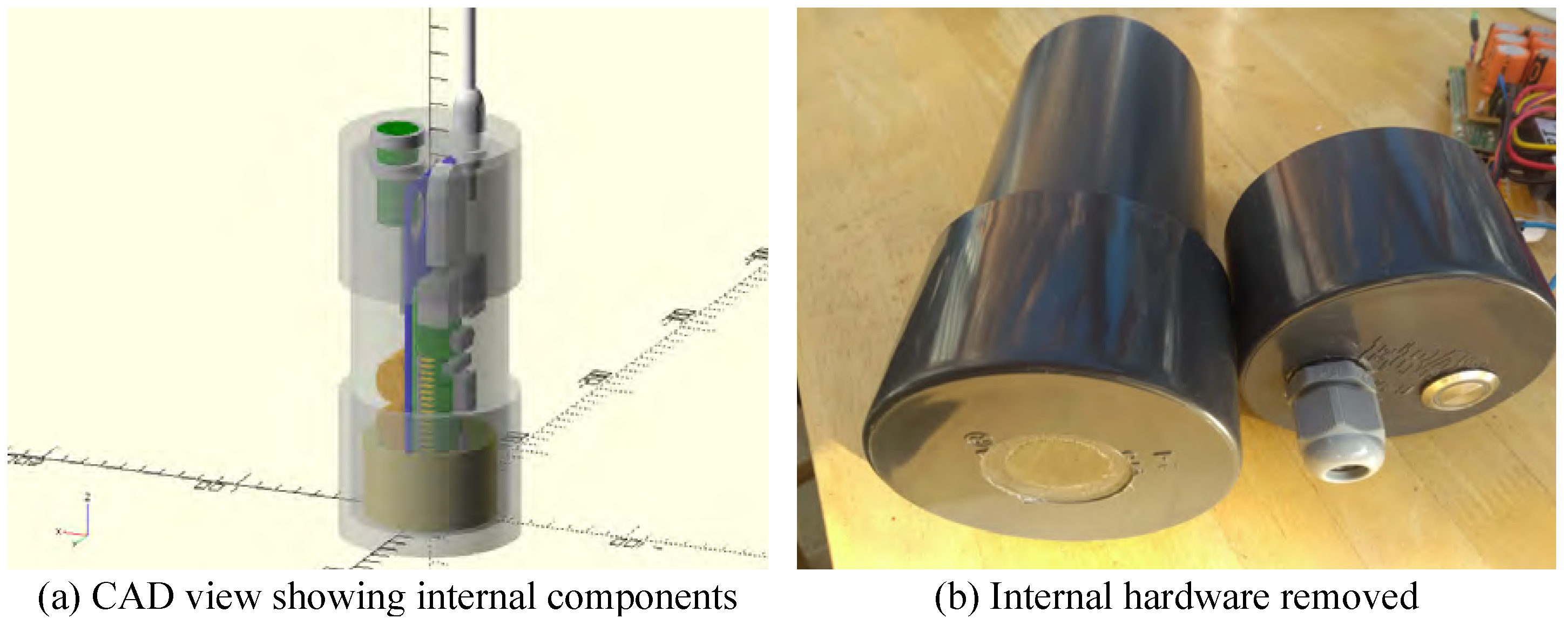


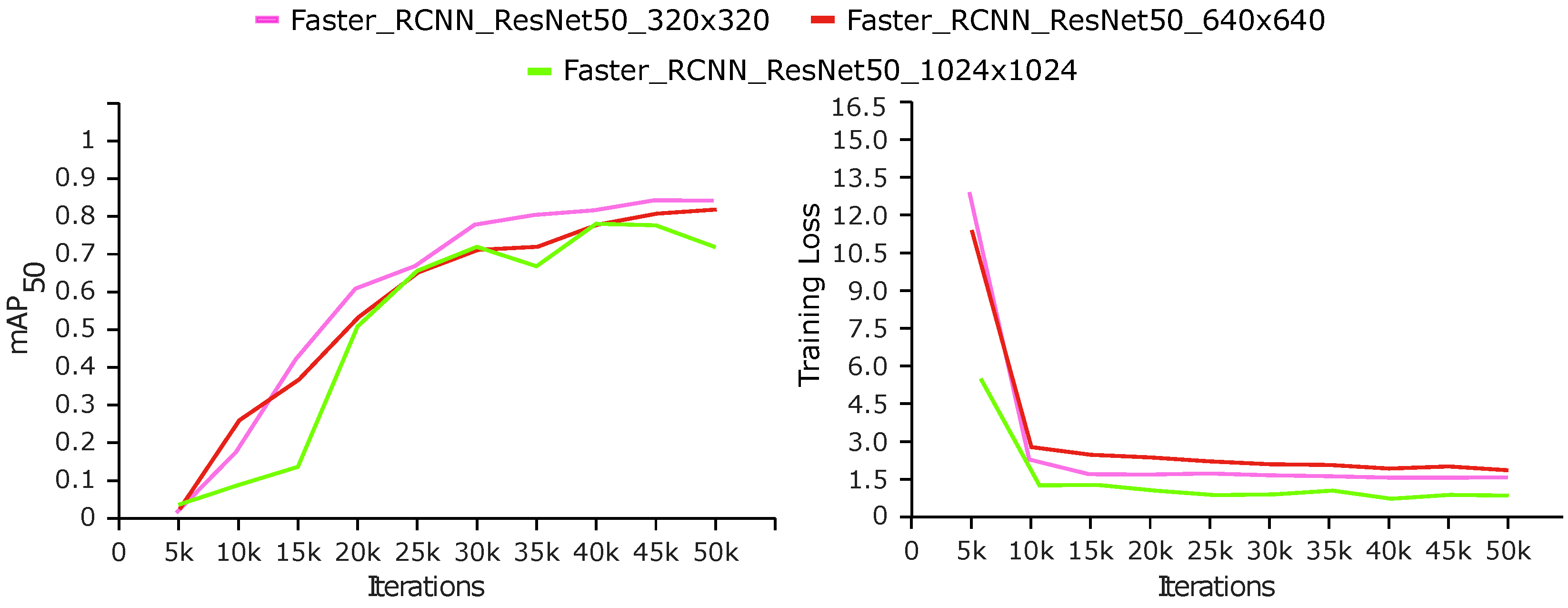
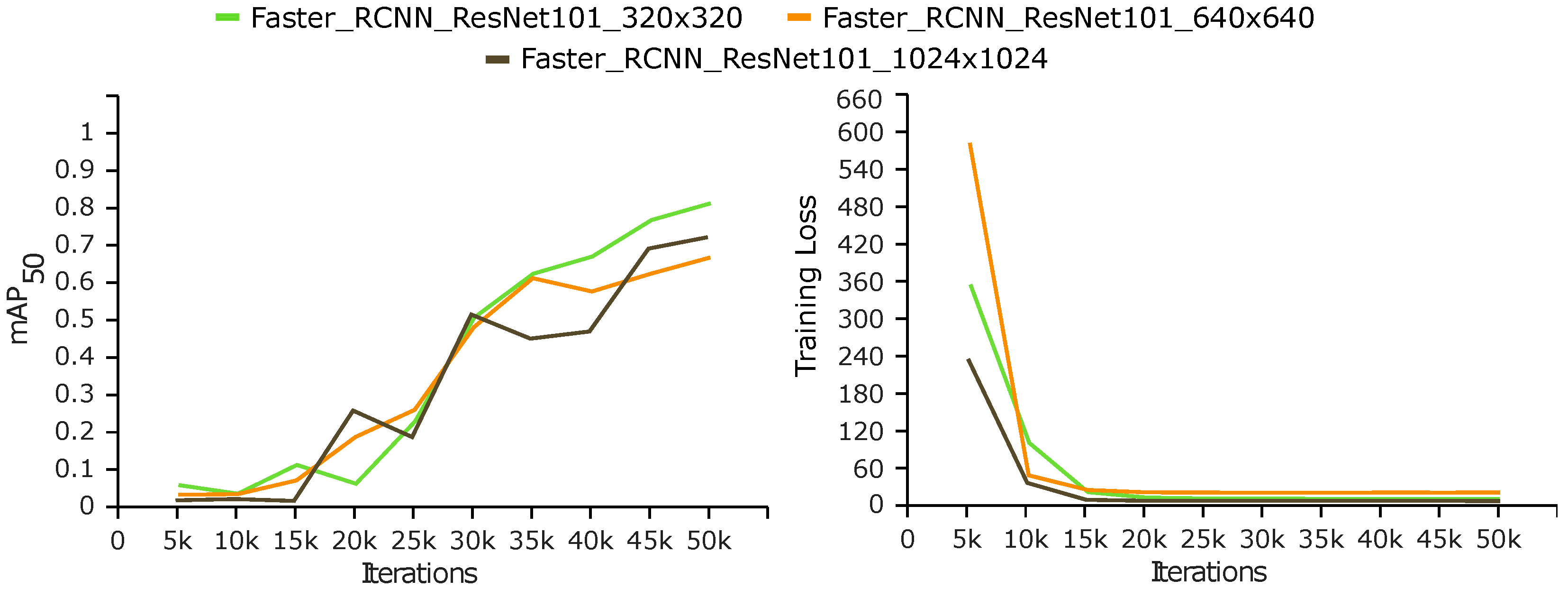
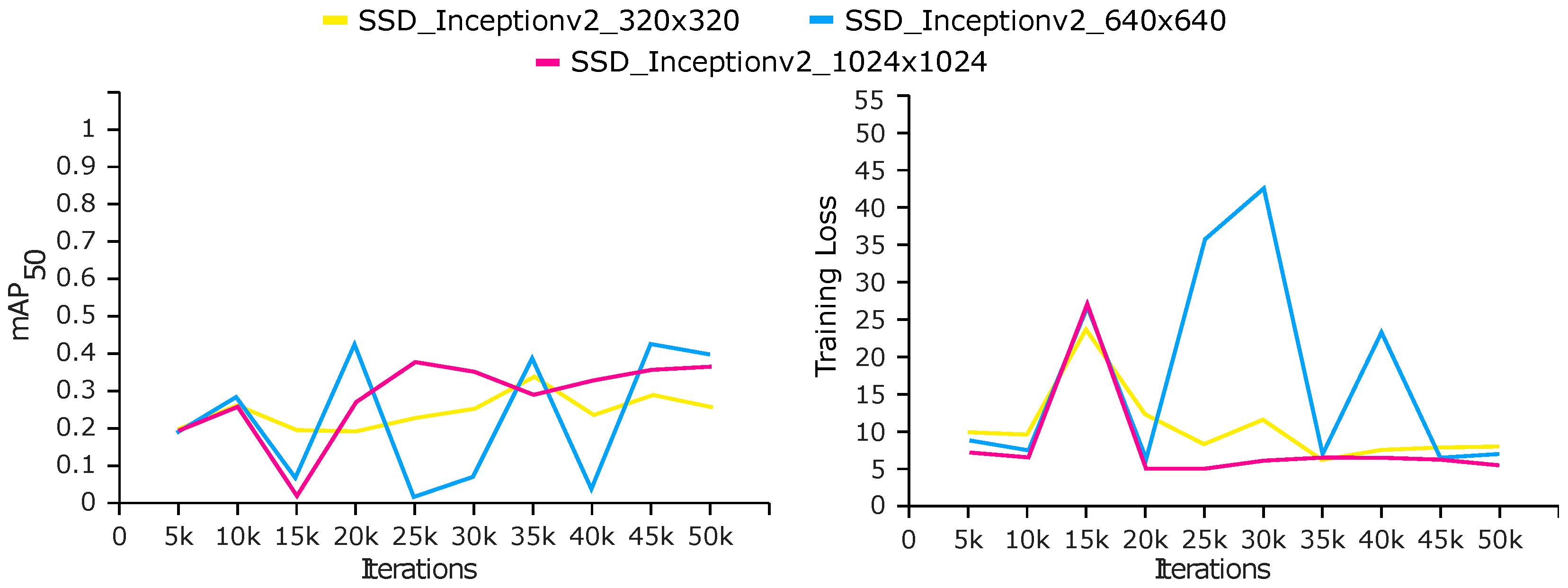
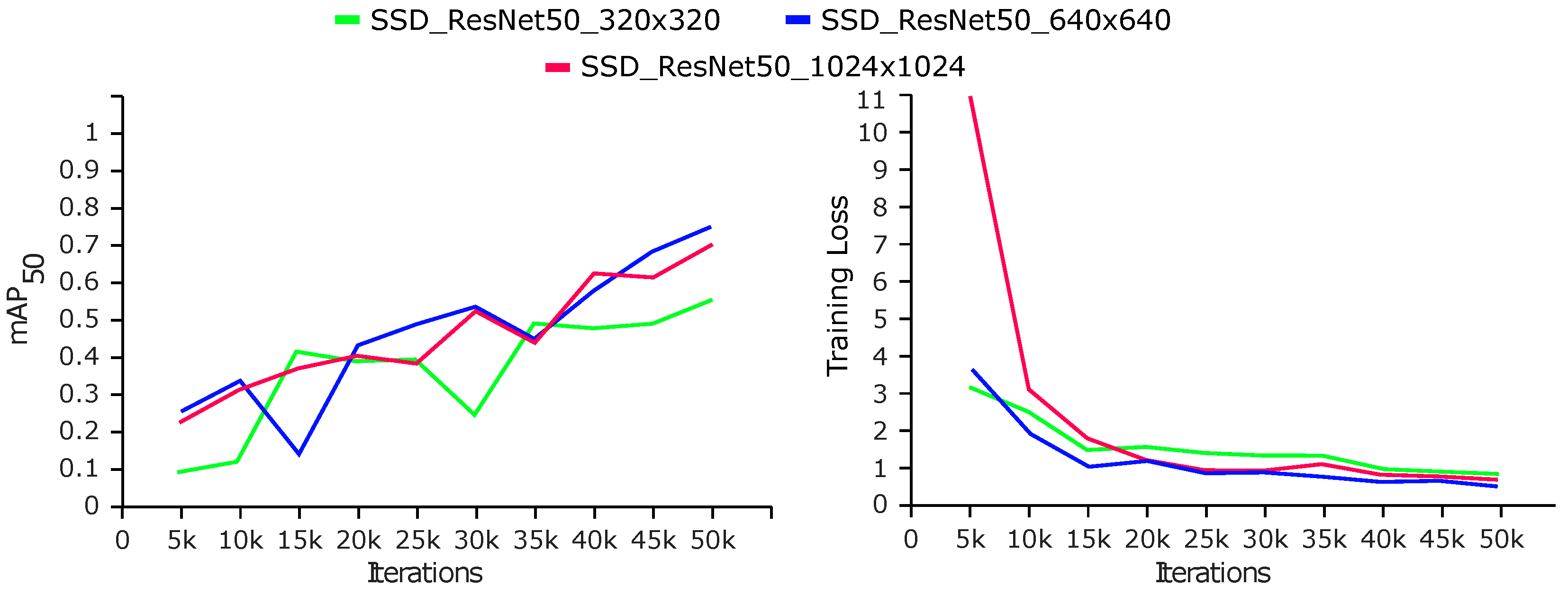
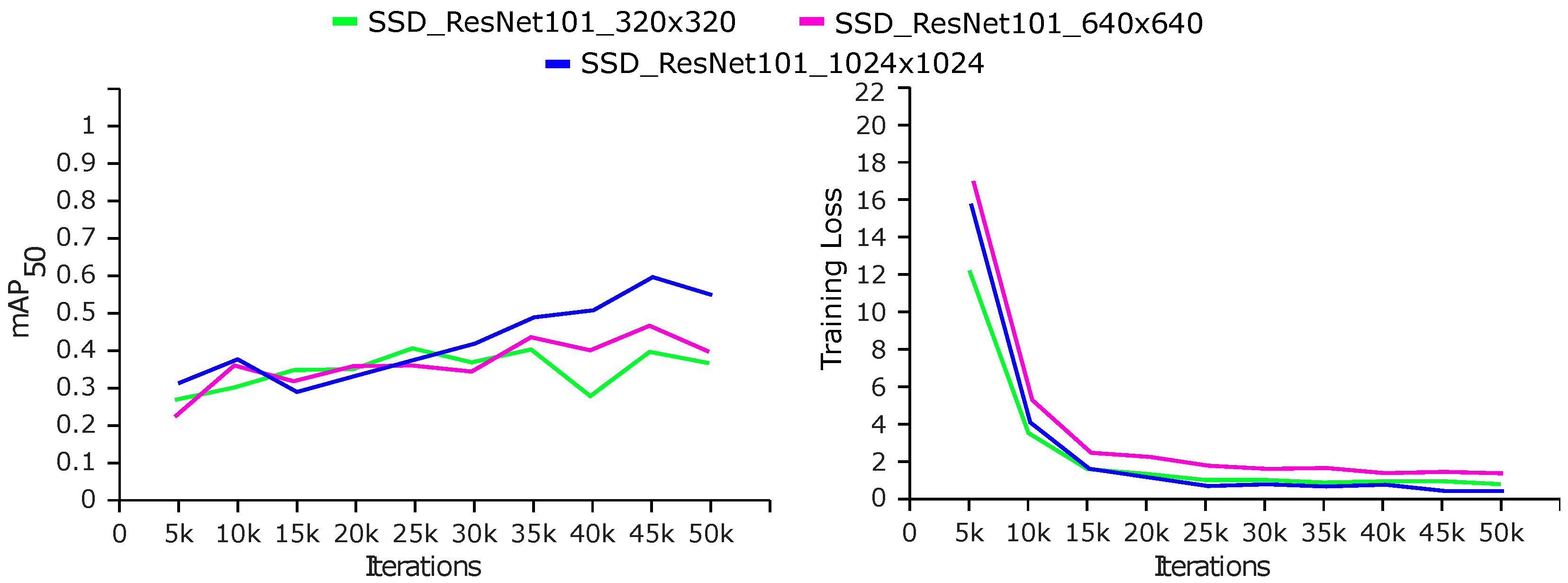
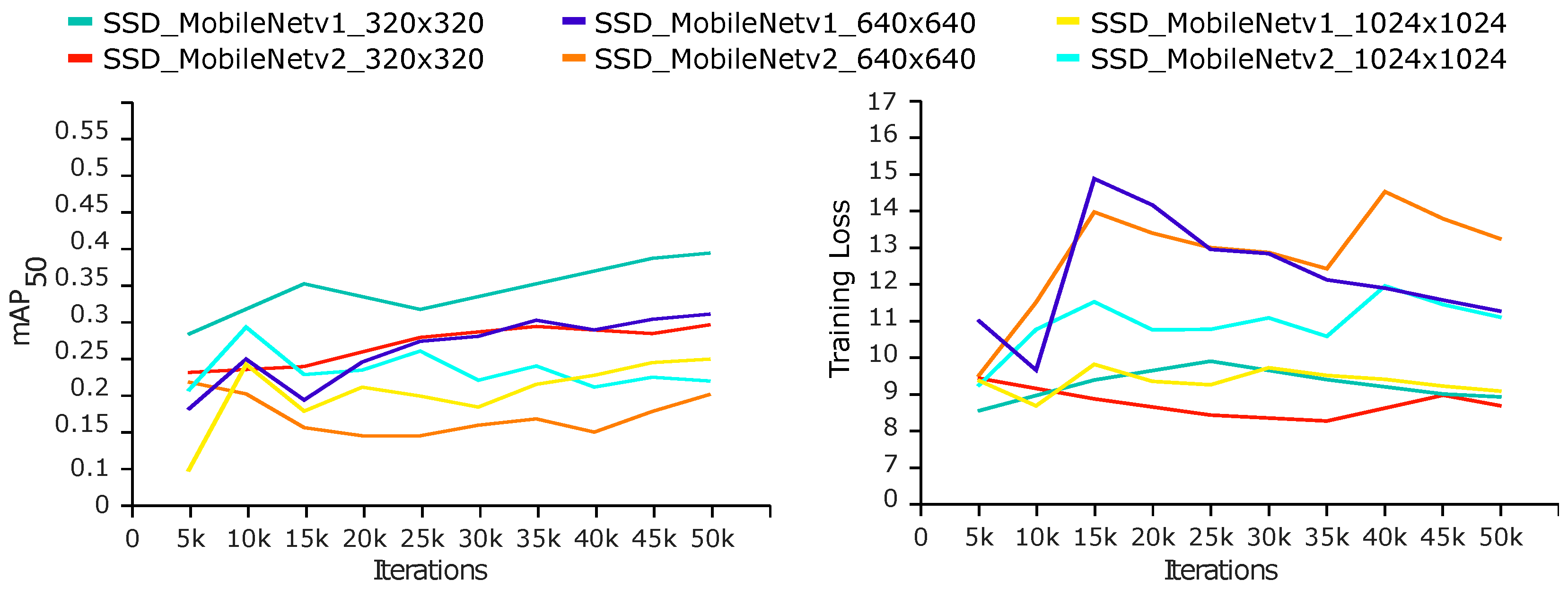
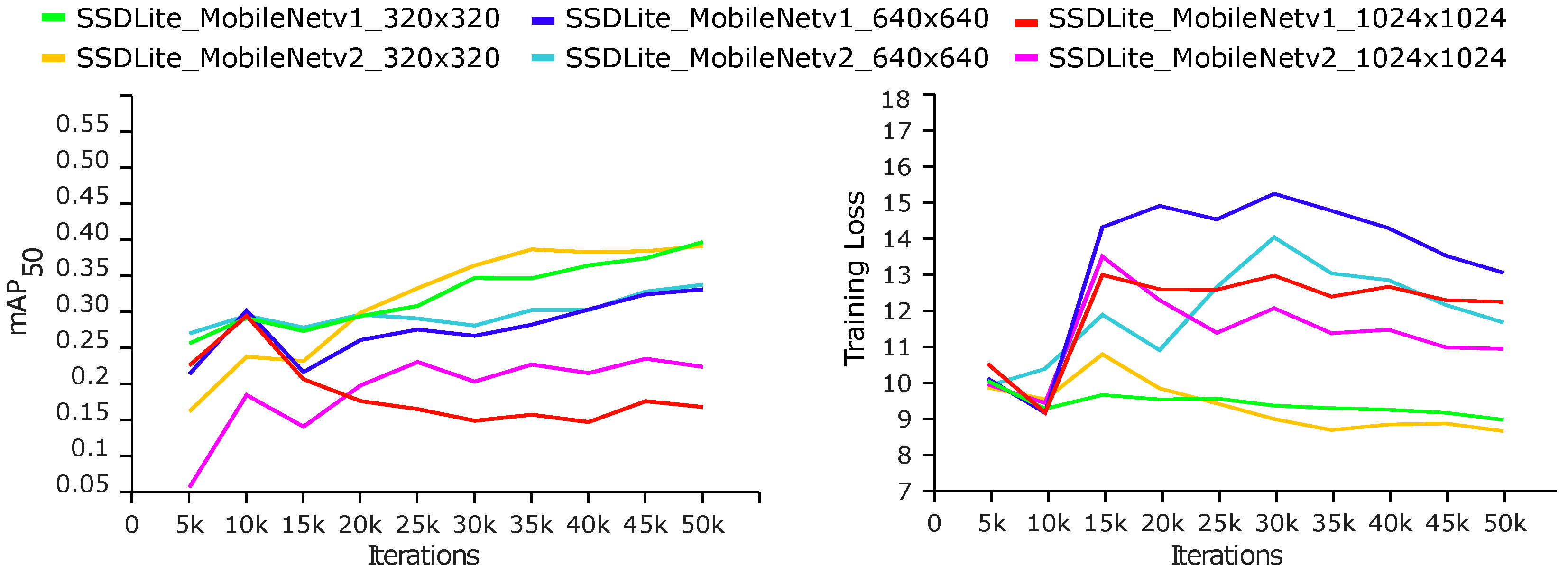
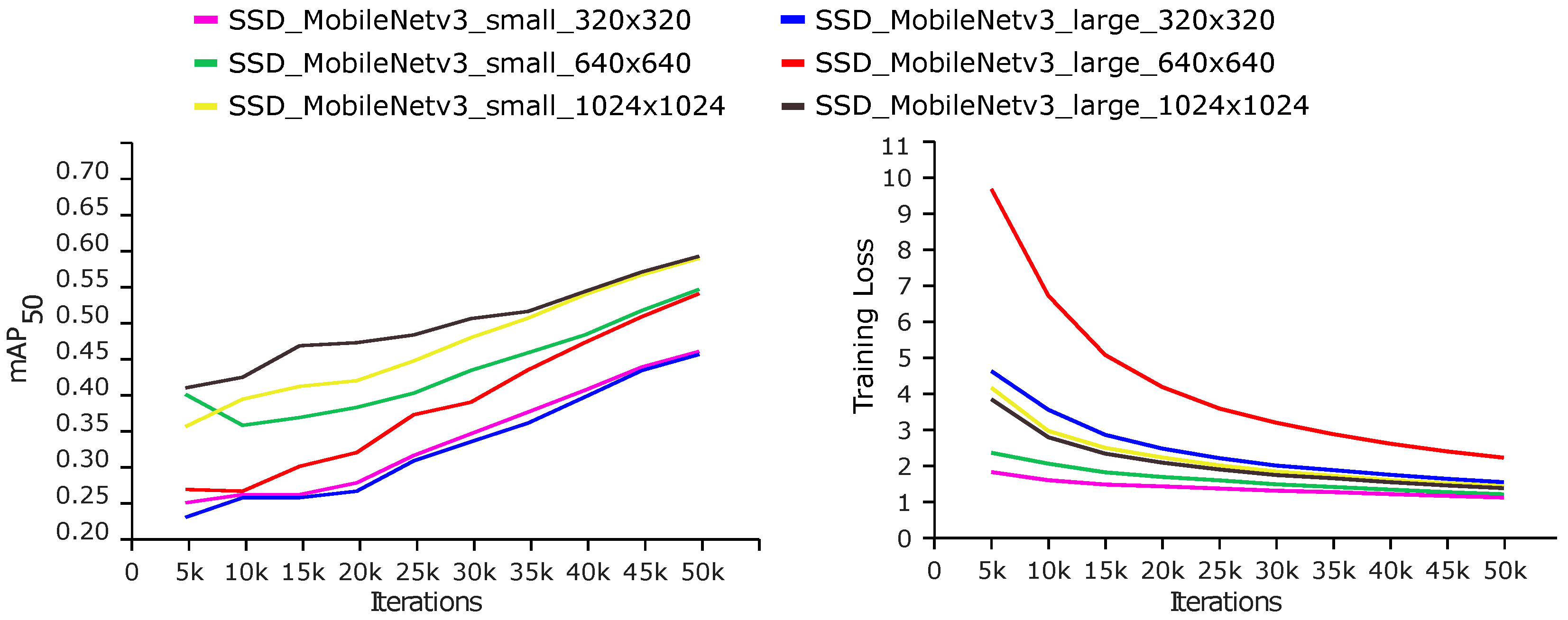

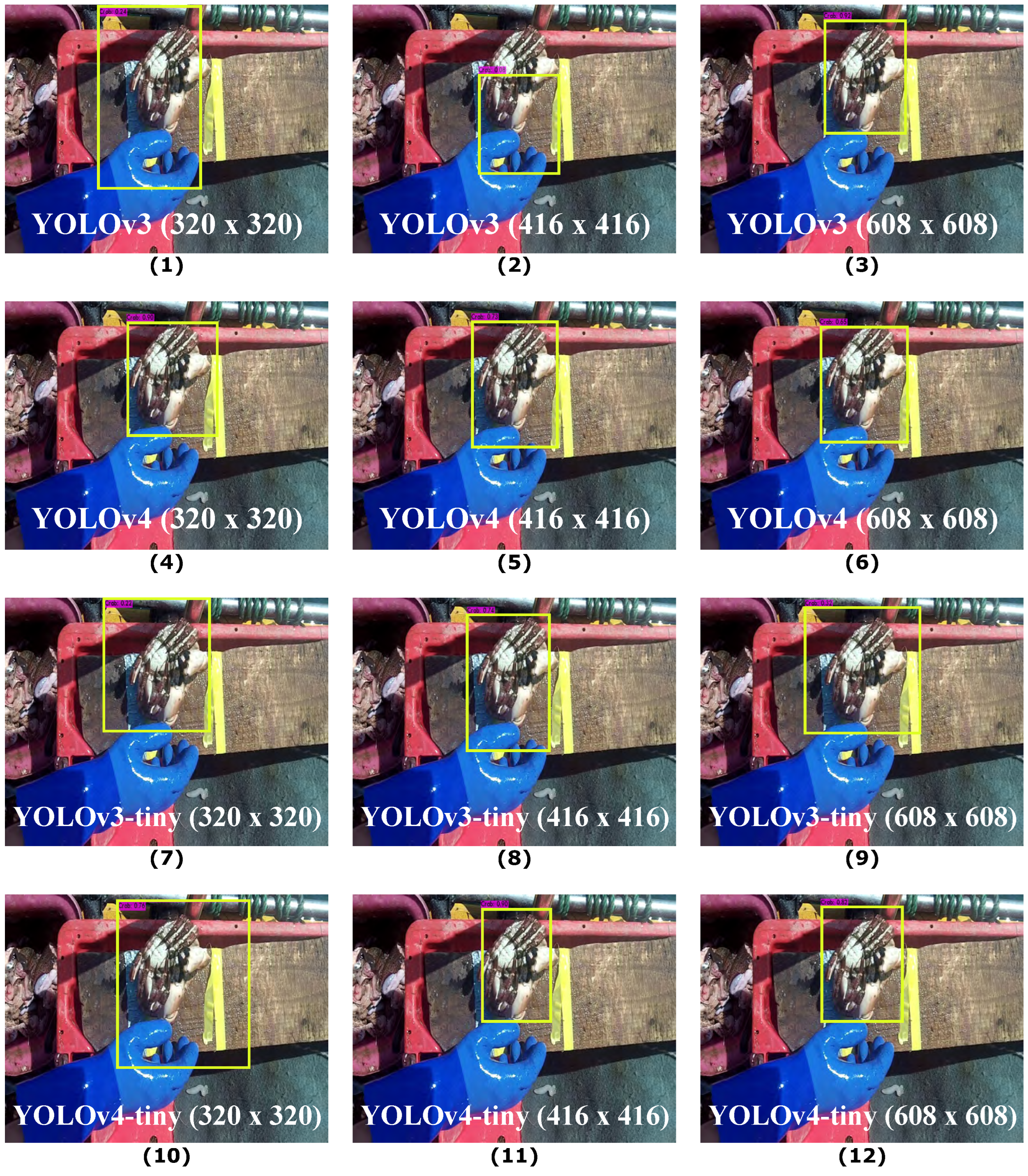

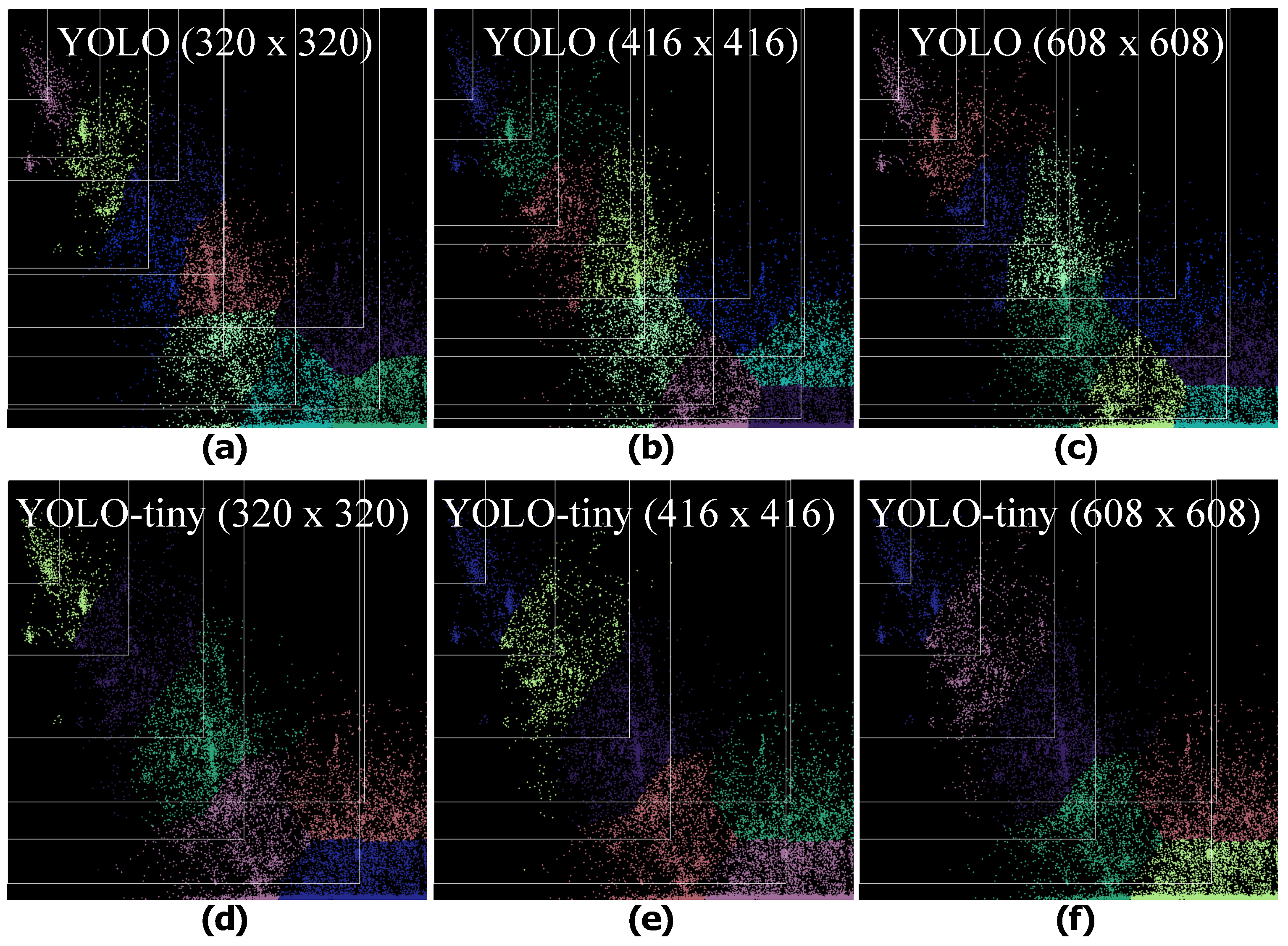
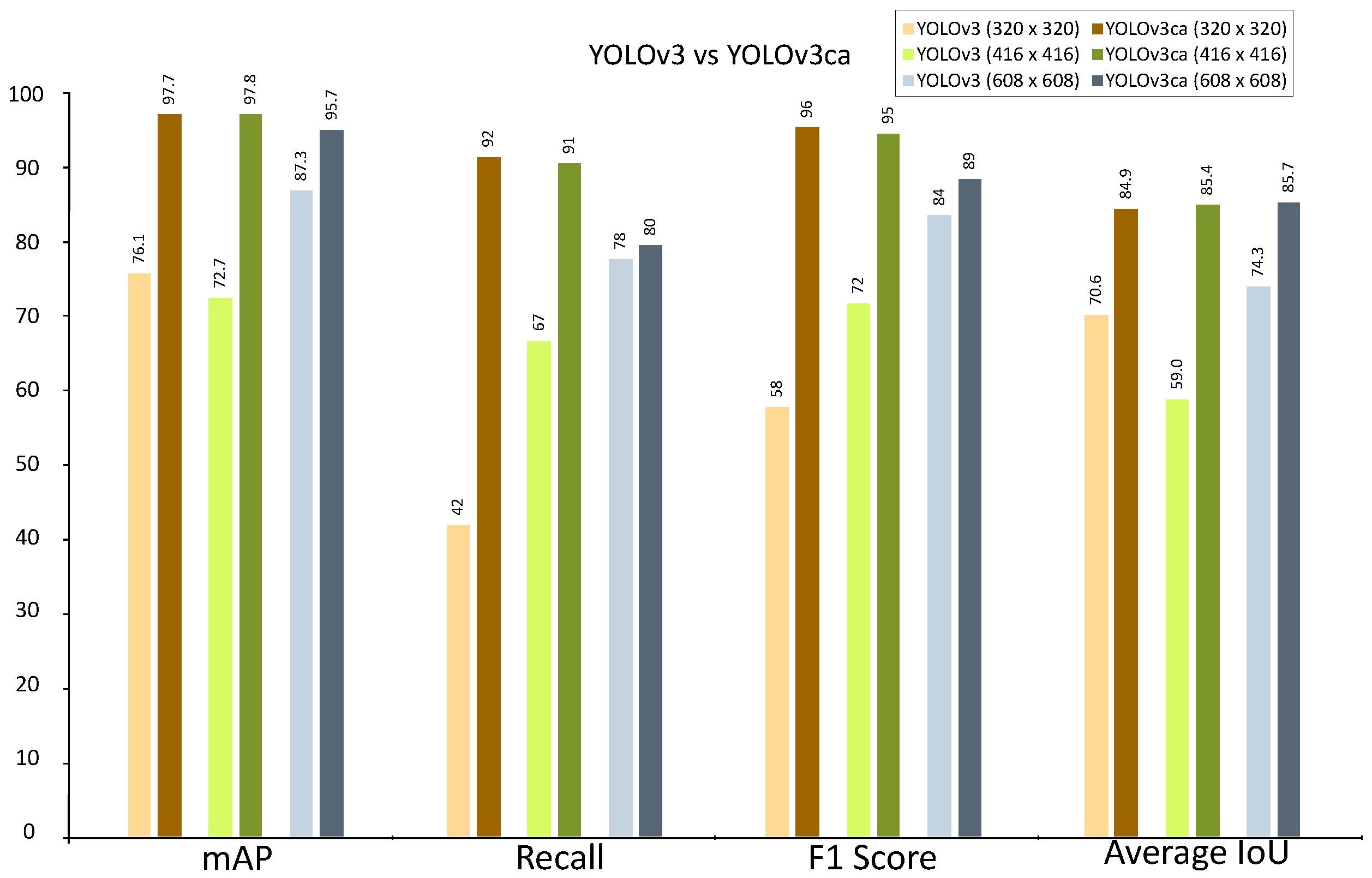
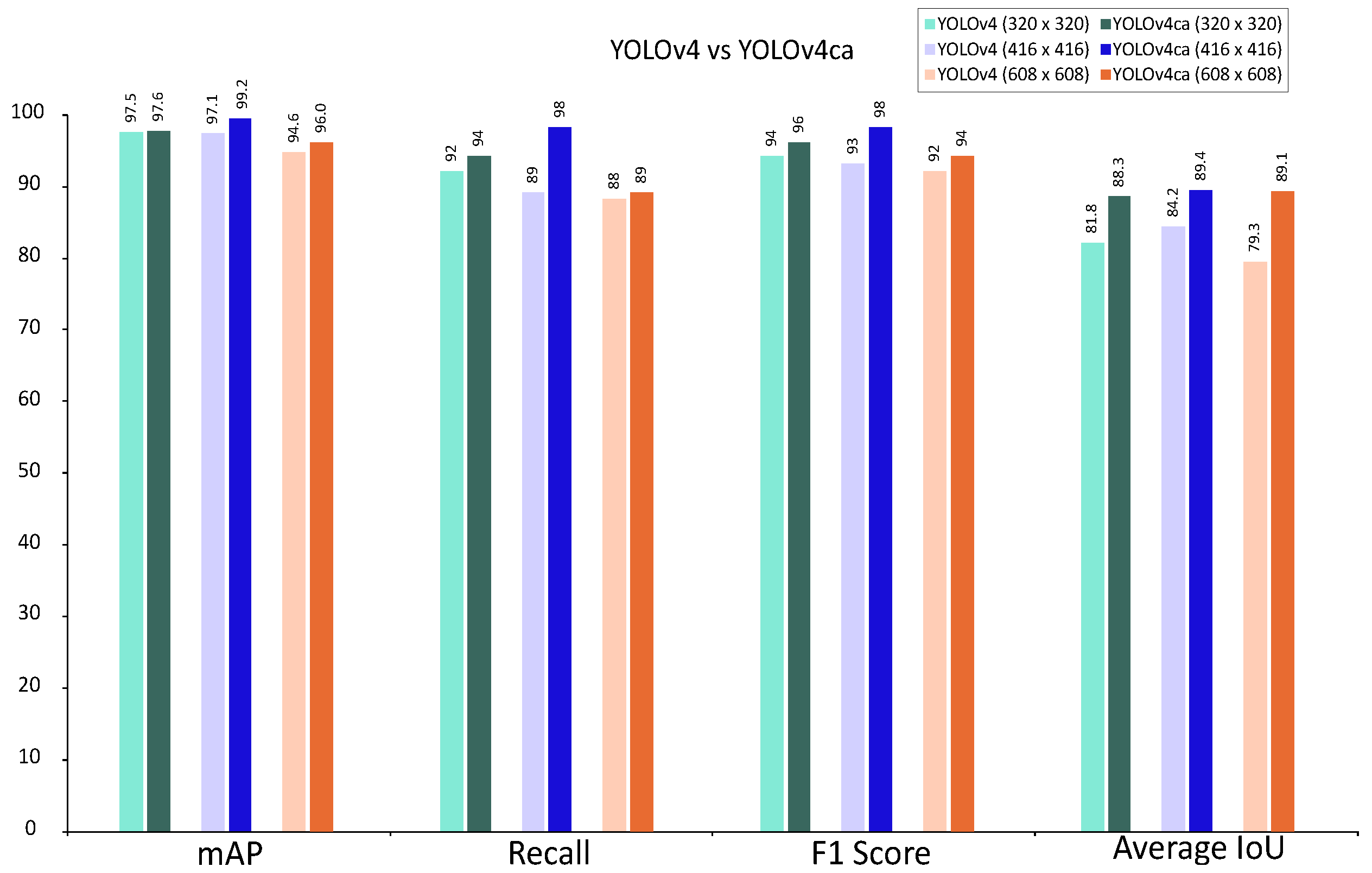
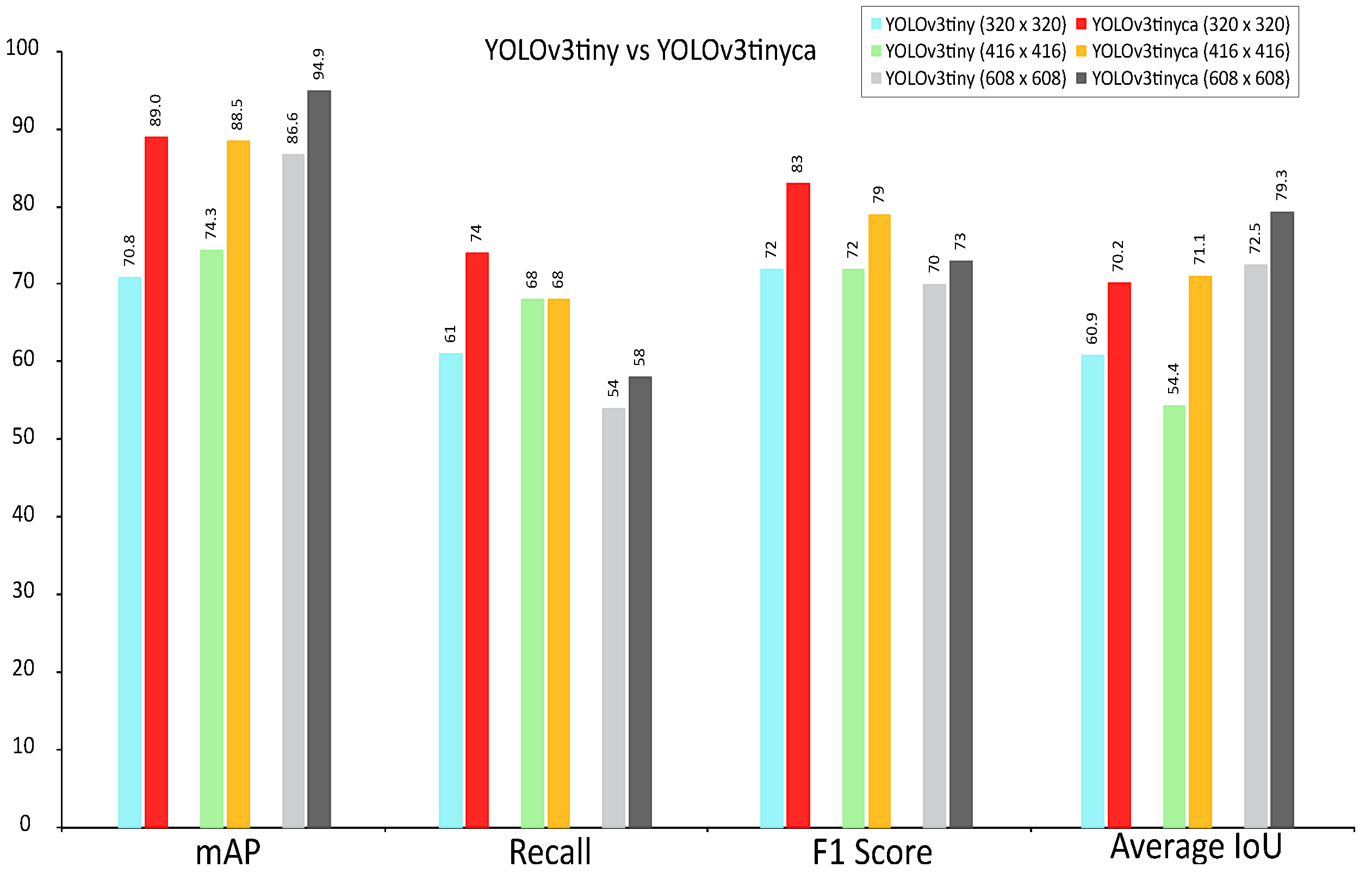

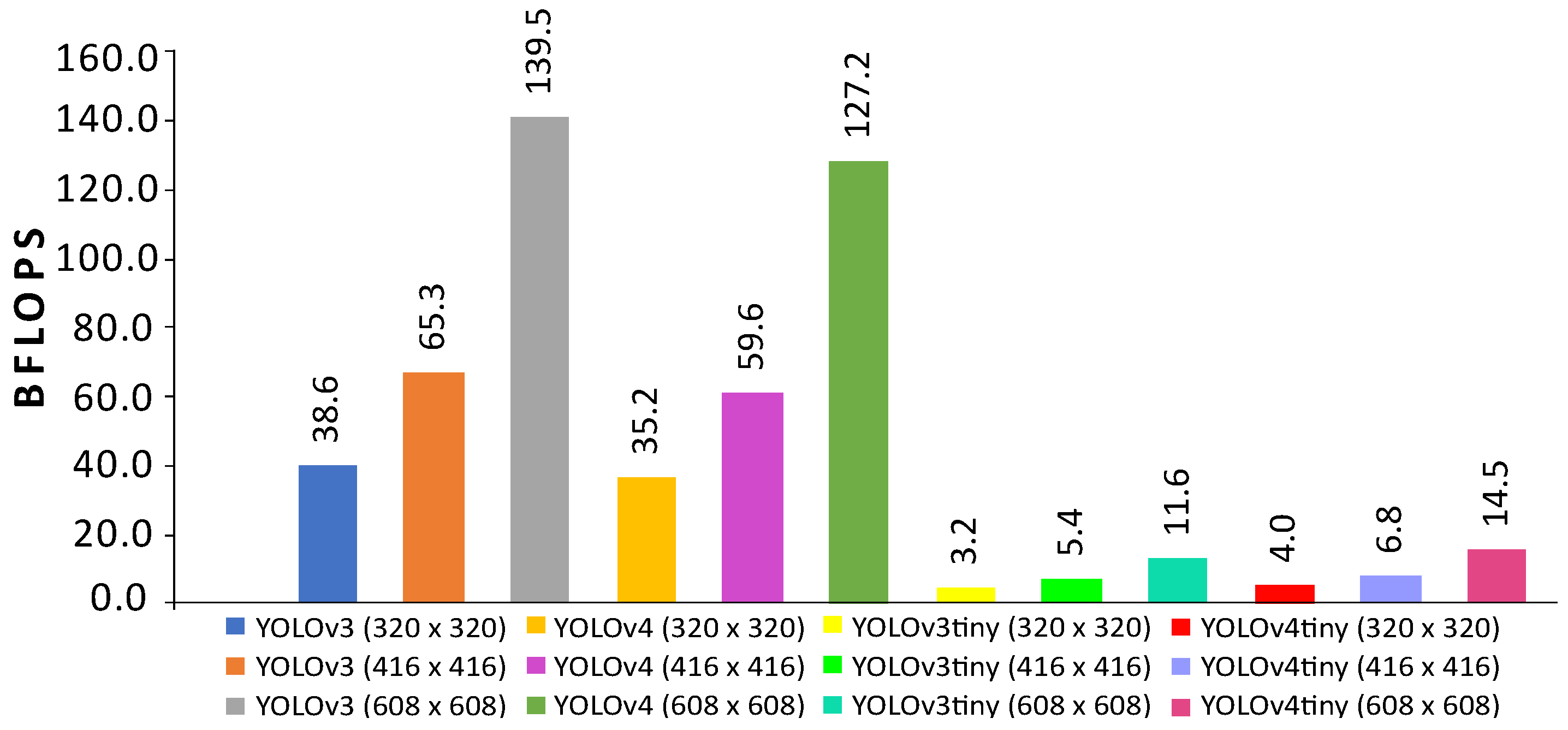
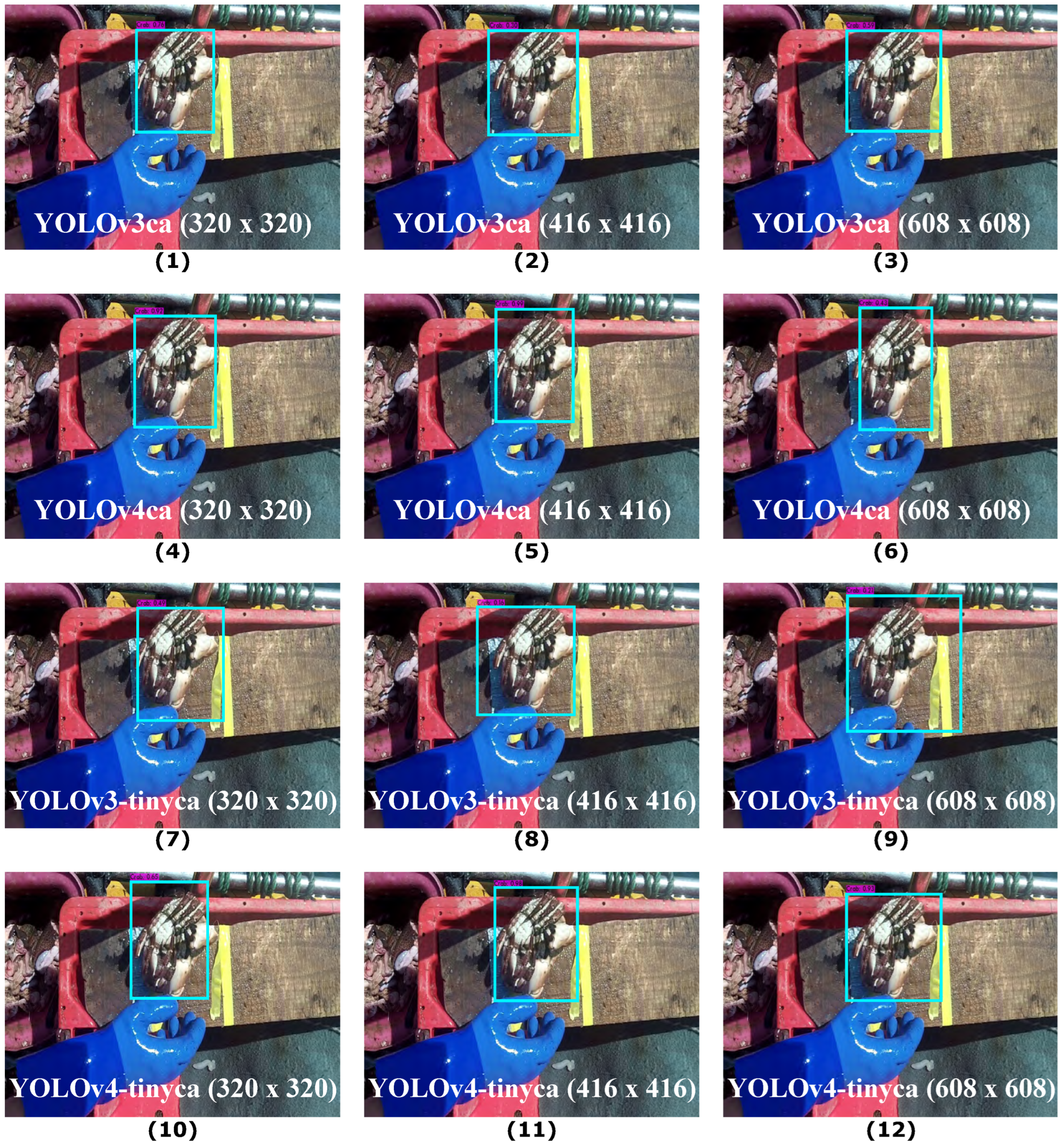

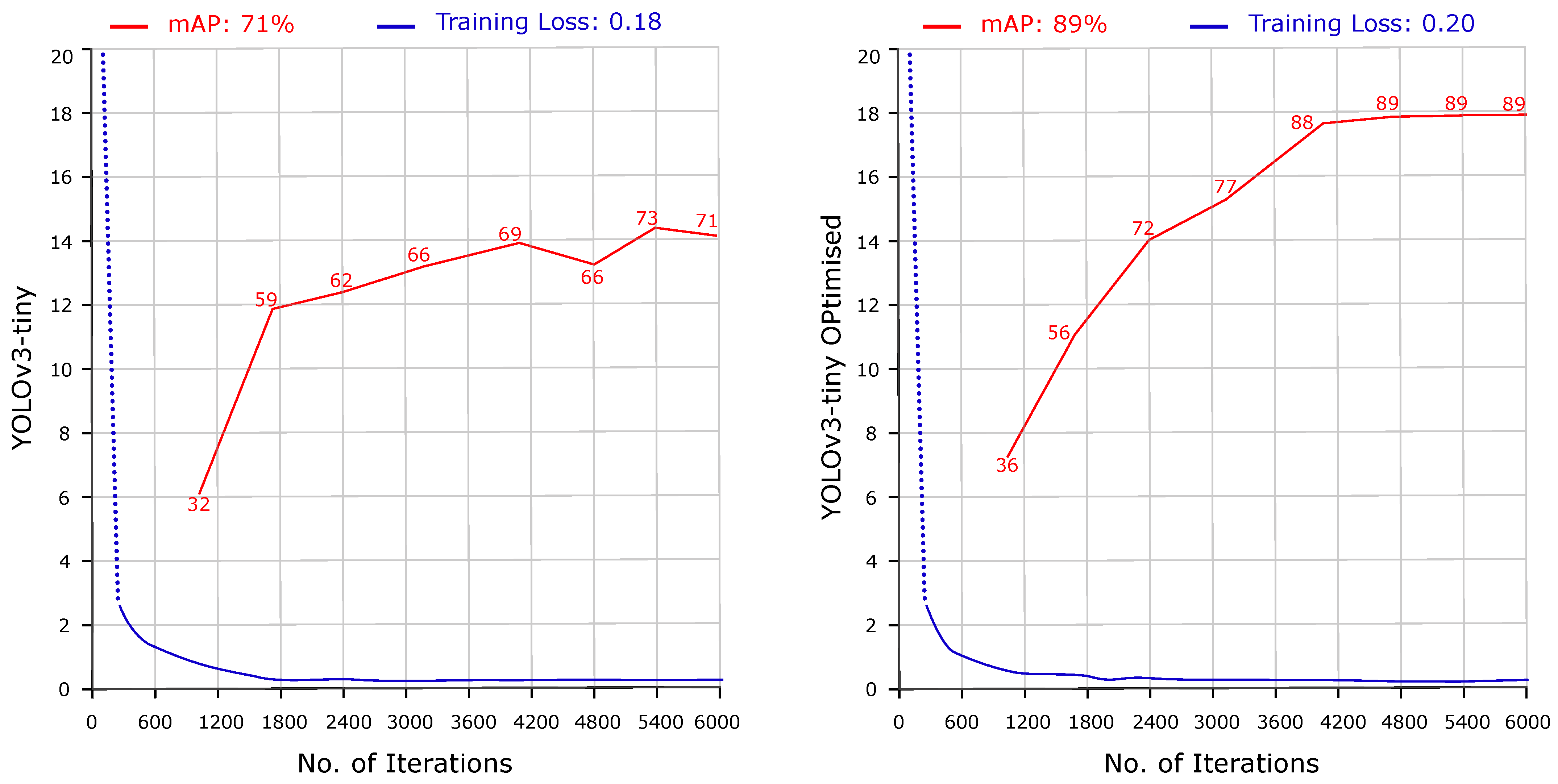
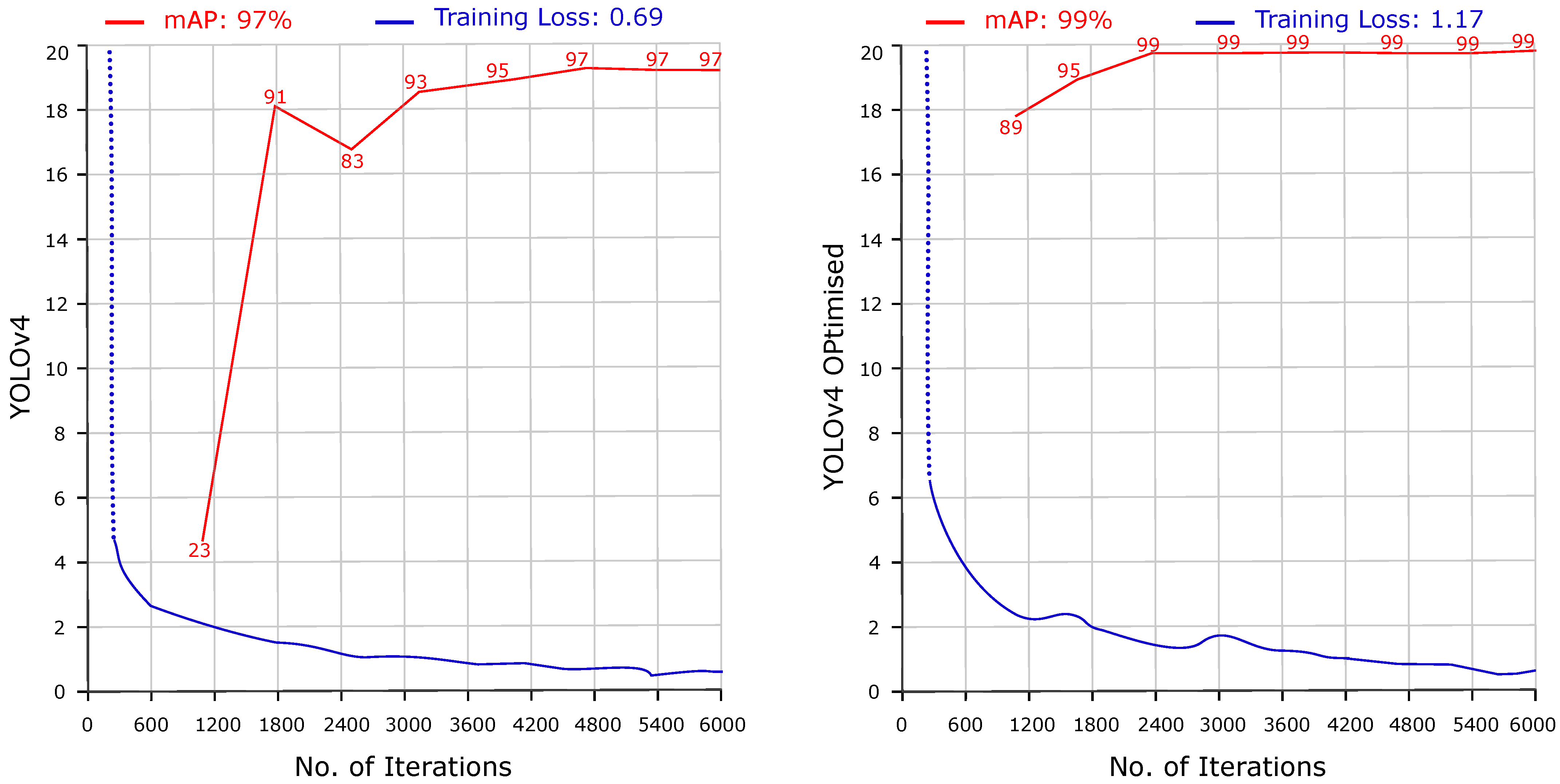

| Article | Author | Method | Application |
|---|---|---|---|
| [27] | Cao et al. | SSD object detector and MobileNetV2 | underwater crab detector |
| [28] | Chin et al. | YOLOv4 | crab detection and sex classification |
| [29] | Ji et al. | MobileCenterNet | underwater river crab detection |
| [30] | Wu et al. | Part-based Deep Learning Network | abdomen parts for identification of swimming and mud crabs |
| [31] | Wang et al. | OTSU algorithm, CNN Classifier | crab knuckle detection |
| [34] | Chelouati et al. | YOLOv3, v4, and v7 | estimate the orientation of lobsters |
| [35] | Cao et al. | LigED and EfficientNet-Det0 | image enhancer for underwater crab detection |
| [36] | Mahmood et al. | YOLOv3 | detection of Western rock lobster |
| [37] | Chelouati et al. | YOLOv4 | detect the main body parts of lobsters |
| [38] | Hasan and Siregar | Edge detection technique | identification, sexing, and age estimation of lobsters |
| S.No. | Network | Input Size | Training Time (hhmm) | Training Steps | mAP50 | mAP75 | Average Recall | F1 Score | Training Loss | FPS |
|---|---|---|---|---|---|---|---|---|---|---|
| 1 | Faster R-CNN Inception v2 | 0241 | 50k | 88.8% | 68.8% | 68.3% | 77.2% | 1.1 | 12 | |
| 2 | Faster R-CNN Inception v2 | 0307 | 50k | 86.0% | 62.8% | 64.9% | 74.0% | 1.3 | 11 | |
| 3 | Faster R-CNN Inception v2 | 0410 | 50k | 85.6% | 61.8% | 65.7% | 74.4% | 0.7 | 8 | |
| 4 | Faster R-CNN ResNet-50 (v1) | 0500 | 50k | 87.1% | 63.2% | 64.7% | 74.3% | 1.6 | 5 | |
| 5 | Faster R-CNN ResNet-50 (v1) | 0540 | 50k | 84.8% | 63.3% | 65.5% | 73.9% | 1.8 | 4 | |
| 6 | Faster R-CNN ResNet-50 (v1) | 0819 | 50k | 77.9% | 50.0% | 63.4% | 69.9% | 0.9 | 4 | |
| 7 | Faster R-CNN ResNet-101 (v1) | 0546 | 50k | 80.4% | 49.3% | 61.7% | 69.8% | 1.4 | 5 | |
| 8 | Faster R-CNN ResNet-101 (v1) | 0708 | 50k | 65.6% | 34.6% | 58.0% | 61.6% | 1.9 | 4 | |
| 9 | Faster R-CNN ResNet-101 (v1) | 1036 | 50k | 73.2% | 39.2% | 59.2% | 65.5% | 1.0 | 3 |
| S.No. | Network | Input Size | Training Time (hhmm) | Training Steps | mAP50 | mAP75 | Average Recall | F1 Score | Training Loss | FPS |
|---|---|---|---|---|---|---|---|---|---|---|
| 1 | SSD Inception v2 | 0255 | 50k | 56.8% | 28.3% | 57.9% | 57.3% | 8.5 | 37 | |
| 2 | SSD Inception v2 | 0310 | 50k | 47.7% | 30.3% | 56.8% | 51.8% | 8.0 | 21 | |
| 3 | SSD Inception v2 | 0655 | 50k | 41.8% | 18.7% | 55.3% | 47.6% | 7.9 | 13 | |
| 4 | SSD ResNet-50 v1 FPN | 0247 | 50k | 57.2% | 46.1% | 69.4% | 62.7% | 0.6 | 21 | |
| 5 | SSD ResNet-50 v1 FPN | 0542 | 50k | 75.7% | 62.8% | 71.3% | 73.4% | 0.6 | 10 | |
| 6 | SSD ResNet-50 v1 FPN | 1053 | 50k | 71.8% | 58.5% | 68.0% | 69.9% | 0.6 | 5 | |
| 7 | SSD ResNet-101 v1 FPN | 0406 | 50k | 47.2% | 37.1% | 64.9% | 54.7% | 0.8 | 14 | |
| 8 | SSD ResNet-101 v1 FPN | 1029 | 50k | 54.1% | 41.1% | 64.2% | 58.7% | 0.9 | 5 | |
| 9 | SSD ResNet-101 v1 FPN | 1105 | 50k | 64.3% | 50.2% | 69.0% | 66.6% | 0.7 | 5 |
| S.No. | Network | Input Size | Training Time (hhmm) | Training Steps | mAP50 | mAP75 | Average Recall | F1 Score | Training Loss | FPS |
|---|---|---|---|---|---|---|---|---|---|---|
| 1 | SSD MobileNetV1 | 0102 | 50k | 53.0% | 35.6% | 57.6% | 55.2% | 8.5 | 41 | |
| 2 | SSD MobileNetV1 | 0237 | 50k | 43.7% | 26.8% | 55.2% | 48.8% | 8.5 | 28 | |
| 3 | SSD MobileNetV1 | 0402 | 50k | 40.3% | 23.8% | 55.7% | 46.8% | 7.9 | 16 | |
| 4 | SSD MobileNetV2 | 0113 | 50k | 36.0% | 21.2% | 53.2% | 43.0% | 7.2 | 41 | |
| 5 | SSD MobileNetV2 | 0252 | 50k | 41.4% | 26.6% | 56.5% | 47.8% | 8.3 | 22 | |
| 6 | SSD MobileNetV2 | 0512 | 50k | 38.2% | 19.2% | 55.8% | 45.4% | 8.0 | 14 | |
| 7 | SSDLite MobileNetV1 | 0124 | 50k | 62.9% | 31.1% | 60.3% | 61.6% | 7.5 | 41 | |
| 8 | SSDLite MobileNetV1 | 0254 | 50k | 51.6% | 24.6% | 55.8% | 53.6% | 8.9 | 30 | |
| 9 | SSDLite MobileNetV1 | 0434 | 50k | 42.5% | 26.8% | 53.7% | 47.5% | 11.6 | 14 | |
| 10 | SSDLite MobileNetV2 | 0135 | 50k | 54.9% | 33.5% | 60.4% | 57.5% | 7.1 | 41 | |
| 11 | SSDLite MobileNetV2 | 0259 | 50k | 56.0% | 33.2% | 59.0% | 57.5% | 7.6 | 25 | |
| 12 | SSDLite MobileNetV2 | 0513 | 50k | 41.1% | 24.9% | 54.9% | 47.0% | 10.5 | 13 | |
| 13 | SSD MobileNetV3-Large | 0135 | 50k | 74.5% | 53.0% | 65.8% | 69.8% | 1.5 | 47 | |
| 14 | SSD MobileNetV3-Large | 0324 | 50k | 84.8% | 60.9% | 68.4% | 75.7% | 2.1 | 30 | |
| 15 | SSD MobileNetV3-Large | 0713 | 50k | 80.7% | 59.1% | 67.8% | 73.7% | 1.3 | 17 | |
| 16 | SSD MobileNetV3-Small | 0117 | 50k | 70.4% | 46.0% | 64.2% | 67.2% | 1.0 | 47 | |
| 17 | SSD MobileNetV3-Small | 0158 | 50k | 83.0% | 60.2% | 68.4% | 75.0% | 0.6 | 41 | |
| 18 | SSD MobileNetV3-Small | 0316 | 50k | 81.6% | 56.2% | 67.2% | 73.7% | 1.3 | 28 |
| S.No. | Network | Input Size | mAP50 | Recall | F1 Score | Average IoU | FPS | BFLOPS | Average Loss | Training Time (hhmm) | Training Iterations |
|---|---|---|---|---|---|---|---|---|---|---|---|
| 1 | YOLOv3 | 76.1% | 42% | 58% | 70.6% | 32 | 38.6 | 0.12 | 0504 | 6k | |
| 2 | YOLOv3 | 72.7% | 67% | 72% | 59.0% | 21 | 65.3 | 0.08 | 0623 | 6k | |
| 3 | YOLOv3 | 87.3% | 78% | 84% | 74.3% | 13 | 139.5 | 0.05 | 1228 | 6k | |
| 4 | YOLOv4 | 97.5% | 92% | 94% | 81.8% | 32 | 35.2 | 0.92 | 0446 | 6k | |
| 5 | YOLOv4 | 97.1% | 89% | 93% | 84.2% | 21 | 59.6 | 0.69 | 0628 | 6k | |
| 6 | YOLOv4 | 94.6% | 88% | 92% | 79.3% | 11 | 127.2 | 0.59 | 1105 | 6k | |
| 7 | YOLOv3-tiny | 70.8% | 61% | 72% | 60.9% | 64 | 3.2 | 0.18 | 0051 | 6k | |
| 8 | YOLOv3-tiny | 74.3% | 68% | 72% | 54.4% | 64 | 5.4 | 0.45 | 0237 | 6k | |
| 9 | YOLOv3-tiny | 86.6% | 54% | 70% | 72.5% | 64 | 11.6 | 0.60 | 0217 | 6k | |
| 10 | YOLOv4-tiny | 68.0% | 59% | 68% | 59.4% | 64 | 4.0 | 0.10 | 0056 | 6k | |
| 11 | YOLOv4-tiny | 74.2% | 80% | 74% | 50.0% | 64 | 6.8 | 0.10 | 0116 | 6k | |
| 12 | YOLOv4-tiny | 85.4% | 68% | 80% | 71.2% | 64 | 14.5 | 0.38 | 0216 | 6k |
| Model | Layers | Parameters (Millions) | Inference Time (Milliseconds) | Weights (MB) | BFLOPS | FPS |
|---|---|---|---|---|---|---|
| YOLOv3 | 106 | 62 | 50 | 235 | 65.3 | 21 |
| YOLOv3-tiny | 24 | 8.7 | 8.3 | 33 | 5.4 | 64 |
| YOLOv4 | 162 | 64.4 | 45.8 | 244 | 59.6 | 21 |
| YOLOv4-tiny | 38 | 6.8 | 8.3 | 22 | 6.8 | 64 |
| S.No. | Network | Image Size (Width × Height) | No. of Clusters | Images | Boxes | No. of Iterations | Counters per Class | Custom Anchors (ca) |
|---|---|---|---|---|---|---|---|---|
| 1 | YOLOv3/YOLOv4 | 9 | 12,080 | 12,809 | 173 | 6479, 6330 | {31,70, 71,114, 131,132, 108,198, 165,203, 165,266, 271,243, 219,302, 284,306 } | |
| 2 | YOLOv3/YOLOv4 | 9 | 12,080 | 12,809 | 95 | 6479, 6330 | {39,90, 96,130, 124,216, 195,234, 209,327, 313,288, 277,393, 368,345, 364,407} | |
| 3 | YOLOv3/YOLOv4 | 9 | 12,080 | 12,809 | 102 | 6479, 6330 | {57,132, 141,190, 181,315, 285,342, 305,478, 458,421, 406,575, 537,504, 532,594} | |
| 4 | YOLOv3-tiny/YOLOv4-tiny | 6 | 12,080 | 12,809 | 82 | 6479, 6330 | {40,79, 92,134, 149,197, 180,274, 272,246, 269,308} | |
| 5 | YOLOv3-tiny/YOLOv4-tiny | 6 | 12,080 | 12,809 | 69 | 6479, 6330 | {52,103, 120,174, 194,256, 234,357, 354,319, 349,400} | |
| 6 | YOLOv3-tiny/YOLOv4-tiny | 6 | 12,080 | 12,809 | 82 | 6479, 6330 | {75,150, 176,254, 284,374, 343,521, 517,467, 511,585} |
| S.No. | Network | Input Size | mAP50 | Recall | F1 Score | Average IoU | FPS | BFLOPS | Average Loss | Training Time (hhmm) | Training Iterations |
|---|---|---|---|---|---|---|---|---|---|---|---|
| 1 | YOLOv3ca | 97.7% | 92% | 96% | 84.9% | 32 | 38.6 | 0.14 | 0322 | 6k | |
| 2 | YOLOv3ca | 97.8% | 91% | 95% | 85.4% | 21 | 65.3 | 0.18 | 0510 | 6k | |
| 3 | YOLOv3ca | 95.7% | 80% | 89% | 85.7% | 13 | 139.5 | 0.32 | 1035 | 6k | |
| 4 | YOLOv4ca | 97.6% | 94% | 96% | 88.3% | 32 | 35.2 | 1.85 | 0416 | 6k | |
| 5 | YOLOv4ca | 99.2% | 98% | 98% | 89.4% | 21 | 59.6 | 1.17 | 0911 | 6k | |
| 6 | YOLOv4ca | 96.0% | 89% | 94% | 89.1% | 11 | 127.2 | 2.47 | 1412 | 6k | |
| 7 | YOLOv3-tinyca | 89.0% | 74% | 83% | 70.2% | 64 | 3.2 | 0.20 | 0052 | 6k | |
| 8 | YOLOv3-tinyca | 88.5% | 68% | 79% | 71.1% | 64 | 5.4 | 0.46 | 0119 | 6k | |
| 9 | YOLOv3-tinyca | 94.9% | 58% | 73% | 79.3% | 64 | 11.6 | 0.66 | 0414 | 6k | |
| 10 | YOLOv4-tinyca | 94.6% | 88% | 93% | 85.0% | 64 | 4.0 | 0.31 | 0042 | 6k | |
| 11 | YOLOv4-tinyca | 95.2% | 93% | 96% | 84.8% | 64 | 6.8 | 0.37 | 0059 | 6k | |
| 12 | YOLOv4-tinyca | 94.3% | 79% | 88% | 80.7% | 64 | 14.5 | 0.50 | 0150 | 6k |
Disclaimer/Publisher’s Note: The statements, opinions and data contained in all publications are solely those of the individual author(s) and contributor(s) and not of MDPI and/or the editor(s). MDPI and/or the editor(s) disclaim responsibility for any injury to people or property resulting from any ideas, methods, instructions or products referred to in the content. |
© 2024 by the authors. Licensee MDPI, Basel, Switzerland. This article is an open access article distributed under the terms and conditions of the Creative Commons Attribution (CC BY) license (https://creativecommons.org/licenses/by/4.0/).
Share and Cite
Iftikhar, M.; Neal, M.; Hold, N.; Gregory Dal Toé, S.; Tiddeman, B. Detection of Crabs and Lobsters Using a Benchmark Single-Stage Detector and Novel Fisheries Dataset. Computers 2024, 13, 119. https://doi.org/10.3390/computers13050119
Iftikhar M, Neal M, Hold N, Gregory Dal Toé S, Tiddeman B. Detection of Crabs and Lobsters Using a Benchmark Single-Stage Detector and Novel Fisheries Dataset. Computers. 2024; 13(5):119. https://doi.org/10.3390/computers13050119
Chicago/Turabian StyleIftikhar, Muhammad, Marie Neal, Natalie Hold, Sebastian Gregory Dal Toé, and Bernard Tiddeman. 2024. "Detection of Crabs and Lobsters Using a Benchmark Single-Stage Detector and Novel Fisheries Dataset" Computers 13, no. 5: 119. https://doi.org/10.3390/computers13050119
APA StyleIftikhar, M., Neal, M., Hold, N., Gregory Dal Toé, S., & Tiddeman, B. (2024). Detection of Crabs and Lobsters Using a Benchmark Single-Stage Detector and Novel Fisheries Dataset. Computers, 13(5), 119. https://doi.org/10.3390/computers13050119






